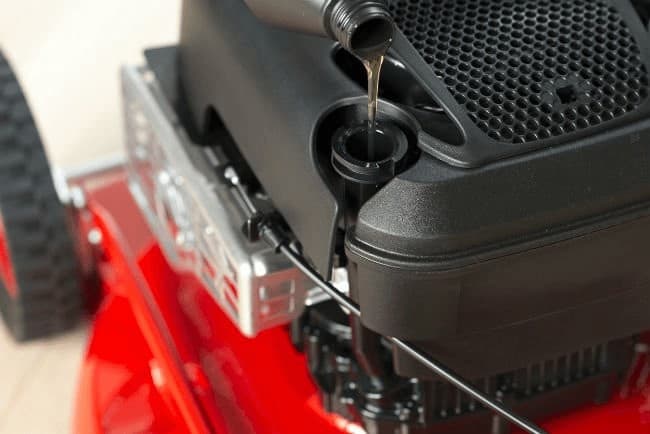How Does a String Trimmer Work?
A string trimmer is the generic name for a weed eater. In addition to Poulan’s famous Weed Eater, a large number of other manufacturers now sell these handy garden tools.
George Ballas, a Texan, conceived the idea of the string trimmer in the 1970s. He was inspired when he watched the revolving brushes in a car wash. He fashioned a prototype using heavy-grade fishing line attached to a can of popcorn which was in turn bolted to an edger.
The manner in which it chewed up the weed surrounding trees prompted him to label it the “Weed Eater.”

These hand-held gardening tools are used to cut weeds, grass and bush in places that a conventional lawnmower just can’t reach.
Weed eaters are very lightweight. Normally they weigh somewhere in the region of 15 to 20 pounds. (Commercial string trimmers are a different animal. Used for cutting roadside grass, these are much beefier and require two hands to operate.)
Trimmers take advantage of micro filament string which spins extremely quickly. It’s similar to fishing line. This cord becomes very stiff and capable of cutting through grass and weeds.
This special line is able to slice through grass without damaging hard surfaces like brick or anything ornamental in the garden. You can buy a string trimmer with an electric, gasoline or even battery-powered engine
GAS, ELECTRIC AND BATTERY STRING TRIMMERS
String trimmers come in many different shapes and sizes. The most powerful versions have four-stroke gasoline engines. This means that they use a combination of oil and gas.
To start the engine you simply pull a ripcord. The flywheel has permanent magnets. Yanking the cord sends a current of electricity to the spark plug.
As the flywheel revolves, the engine fires up. Fuel in the combustion chamber is ignited and this drives the crankshaft. Electric and battery models work in a similar fashion to each other.
The flywheel is rotated by means of the electric current surging through. Unlike the string trimmers that run on gas, with these types they start as soon as they have power.
What are the main differences between gas and electric string trimmers?

Electrical weed eaters normally have the motor in the head. With the gas-powered variety the motor is usually at the other end of the shaft from the head. To generalize, the combustion-engine powered trimmers are more powerful than electrical ones.
As a rule, electrical engines feature a string limited to 2.55mm in diameter. This is because they can only pull somewhere in the region of 1200 watts of electricity.
The quietest string trimmers are electrical. They also need much less maintenance. Advances in electrical models mean that cords are not now necessary. They run on batteries instead.
This may be convenient but it’s bumped the price up. Also, you will only get around 20 minutes of running time before needing to recharge the batteries. This can be tiresome.
These cordless models are heavier than their corded brethren. They can only meaningfully be used for very light trimming. Compare this to the raw power of gasoline-fuelled weed eaters.
These can very easily cut a swathe through tall grass and stiff, woody brush. Finally, gas string trimmers can also be employed for edging purposes. While they do still kick out emissions, advances in technology are reducing them (although they are still not emission-free).
Trimmer Head
The trimmer head is attached by bolts to a spindle. This is connected to the drive shaft. The head is the part of the weed eater that holds the string. String is wound around a spool and then extends through holes in the cap surrounding it.
Some string trimmers have special mechanisms which push out more string automatically as it wears away. Other kinds advance the cord when you hit the cap’s top on the floor.
You have two choices when it comes to getting fresh string. You can replace the entire cap or wind up the loose string on the spool yourself.
Clutch, Trimmer Head and Drive Shaft
In a gasoline weed eater, there is a connection between the engine crankshaft and a centrifugal clutch. This assembly connects in turn to a drive shaft which goes fully through the shaft of the machine and ends up at the trimmer head.
Wings on the clutch stay retracted when the engine idles. These wings then splay out as the throttle is engaged by means of a trigger. This process engages the drive shaft and the trimmer head begins turning.
At full tilt, the string’s end can reach astonishing speeds of 28,000 feet a minute. This is more than enough pace to cut easily through thick grass and tough weeds.
Cutting Action
When the motor is fired up, the string on your trimmer revolves at high velocity. This speed is anywhere between 3000 rpm and 10,000 rpm. The line spins out from the cartrdidge due to centrifugal force.
In most aspects, string trimmers differ slightly. The cutting swath can be from 8 to 22 inches in diameter. Most models spin a diameter in the lower range.
Usage of String Trimmers
It’s critical to first string the head of the device. Some of the newer kinds of trimmers require just a cartridge replacement when the cord has been used up. Also, in the event of the string snapping, these newer cartridges will automatically replenish the nylon.
Handy Operation Hints
Take care when using the choke or priming bulb. This is a feature which helps when starting your gasoline weed eater cold. As the function varies, it’s crucial to consult the manual. If you fail to follow the instructions you have a high chance of flooding the carburetor.
String diameters vary. They usually measure between 0.065 to 0.090 inches. Installing the wrong type of string will result in malfunction. Again, check the owner’s manual and buy the right kind of string.
Take advantage of the guard provided. This will stop rocks, stones or other debris from shooting up into your face. It’s a wise idea to wear safety glasses too.





